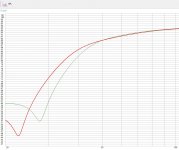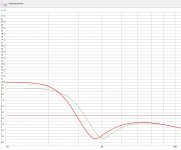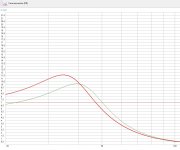I'm comparing two small subwoofers, each featuring a pair of drivers and a pair of passive radiators. In these 2 models, the drivers are identical but the passive radiators are different. The box is the same in both models. The input power is the same in both models.
WinISD shows one design having higher SPL below a certain low frequency. That design uses slightly smaller passive radiators (80 mm VS 90 mm). In addition, the models show that design with the smaller passive radiators also has lower driver excursion in that frequency band, AND lower passive radiator excursion.
How is it possible for two designs that differ only by the passive radiators that the design with smaller PRs, lower driver excursion, and lower PR excursion plays louder at a given frequency? What am I missing?
I have checked every input multiple times. Same drivers. Same driver count. Same passive radiator count. Same box size. Same input power.
Am I losing my mind? Shouldn't larger excursion with larger passive radiators play louder?
WinISD shows one design having higher SPL below a certain low frequency. That design uses slightly smaller passive radiators (80 mm VS 90 mm). In addition, the models show that design with the smaller passive radiators also has lower driver excursion in that frequency band, AND lower passive radiator excursion.
How is it possible for two designs that differ only by the passive radiators that the design with smaller PRs, lower driver excursion, and lower PR excursion plays louder at a given frequency? What am I missing?
I have checked every input multiple times. Same drivers. Same driver count. Same passive radiator count. Same box size. Same input power.
Am I losing my mind? Shouldn't larger excursion with larger passive radiators play louder?
The smaller PR probably has a higher Fs and therefore the Fb is higher giving the result you are seeing. To see the effect, add some mass to the small PR to show what happens when the Fs is lowered.
You may want to post some screen shots to clarify "below a certain low frequency".
It's the same effect when you tune a vented box higher.
You may want to post some screen shots to clarify "below a certain low frequency".
It's the same effect when you tune a vented box higher.
I don't see it. How can one configuration have
(1) higher driver excursion (same driver)
(2) higher PR excursion (larger PR)
(3) lower SPL
None of this makes sense. The volume displacement calcs alone would lead one to believe the other configuration should be louder.
Same driver, more excursion --> louder.
Larger PR, more excursion --> louder
But WinISD says it's quieter.
By the way, the smaller PR has a much lower Fs (unloaded) --> 35 Hz versus 54 Hz. As loaded, WinISD says the natural frequencies drop to 23 Hz and 28 Hz, respectively.
Regardless, I think the displacements should tell all, and they don't. How is less volume displacement louder?
(1) higher driver excursion (same driver)
(2) higher PR excursion (larger PR)
(3) lower SPL
None of this makes sense. The volume displacement calcs alone would lead one to believe the other configuration should be louder.
Same driver, more excursion --> louder.
Larger PR, more excursion --> louder
But WinISD says it's quieter.
By the way, the smaller PR has a much lower Fs (unloaded) --> 35 Hz versus 54 Hz. As loaded, WinISD says the natural frequencies drop to 23 Hz and 28 Hz, respectively.
Regardless, I think the displacements should tell all, and they don't. How is less volume displacement louder?
Remember that you need 4x displacement to go an octave down. Are you comparing equal frequencies?
This would be easier if you posted graphs...
Chris
This would be easier if you posted graphs...
Chris
Thanks for continuing to help! Yes, I'm looking at the same frequencies. Here are plots of SPL and both driver & PR excursion. Look in the range between ~ 41 Hz to ~ 48 Hz.
RED = smaller PRs
GREEN = larger PRs
Lower excursion (drivers & PRs) --> higher SPL
???
RED = smaller PRs
GREEN = larger PRs
Lower excursion (drivers & PRs) --> higher SPL
???
Attachments
Last edited:
Hmm, your 2nd plot shows different box tunings [Fb] with one @ ~50 Hz, the other @ ~45 Hz, so to compare them requires adding/removing some mass from the PRs as required to make the plots overlap at whatever [Fb] desired.
Factor in they have different size PRs means the larger one will resonate at a lower frequency for a given [Fb], i.e. view it as having a longer vent length, hence a lower pipe harmonic structure relative to the smaller area, shorter vent length, PR.
GM
Factor in they have different size PRs means the larger one will resonate at a lower frequency for a given [Fb], i.e. view it as having a longer vent length, hence a lower pipe harmonic structure relative to the smaller area, shorter vent length, PR.
GM
Interesting. I'm still having a hard time getting past the excursion numbers. There is no doubt the box with the smaller PR is pushing less air -- both driver and PR have less displacement.
How does air volume displacement ultimately not tell the whole story?
How does air volume displacement ultimately not tell the whole story?
Air volume displacement alone does not "tell the story" of whether the passive radiator and driver cone output are "in phase".How does air volume displacement ultimately not tell the whole story?
Ha! That is exactly the light bulb that came on for me a few minutes ago. Of course magnitude isn't the whole story. I am glad you confirmed it. I can't plot the phase of excursion in WinISD, but I'm pretty sure that's it. The smaller passive radiators are more in phase with the drivers over that frequency band and so the outputs sum "better".
Thanks, everyone. I was pretty sure the analysis wasn't wrong, but I was struggling to put my finger on why.
Thanks, everyone. I was pretty sure the analysis wasn't wrong, but I was struggling to put my finger on why.
- Status
- Not open for further replies.
- Home
- Loudspeakers
- Subwoofers
- WinISD question -- can this be right?


